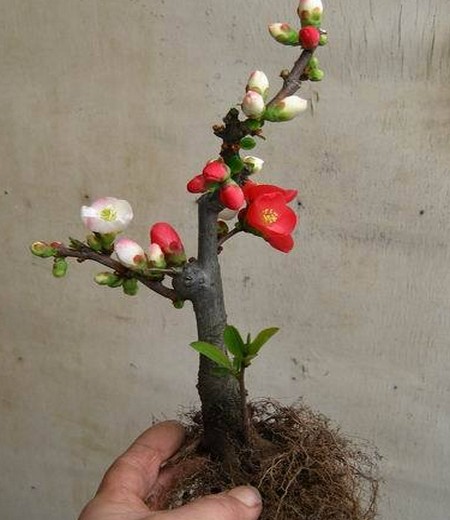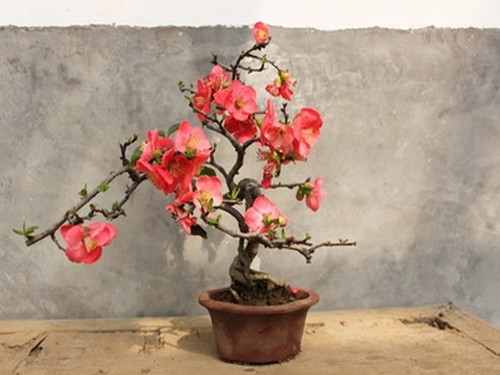Pruning technique of potted crabapple with sticking stem
The tree with stem begonia has strong potential, strong sprouting power, easy to be disorderly in shape and resistant to pruning. The flower bud belongs to the summer and autumn differentiation type, and the flower bud centralized differentiation period is from July to August. The axillary buds of the middle and lower part of the spring shoot often differentiate into flower buds, blossom in the next spring and form short flowering branches. In the well-developed oblique biennial lateral branches, almost all axillary buds except the apex can differentiate into flower buds. The tips of short branches and full-growing axillary buds on perennial branches can also differentiate into flower buds. Therefore, pruning must promote the occurrence of most flowering short branches and retain a certain number of mother branches.
Pruning is the best when the tree has not germinated in early spring, and the pruning methods are mainly short cutting and branch thinning. The root of Tripterygium has strong ability to sprout, and a lot of tillers germinate from the base of the plant every year. 2-3 sturdy sprouting and tillering branches can be selected and truncated to be used as regeneration branches, while 2-3 old branches can be removed every year. In this way, there are new branches and senescent branches left every year, which can keep a certain number of branches in the clump. Such repeated pruning can keep the shrub exuberant vitality for a long time, blossom continuously, and greatly improve the ornamental value.
The pruning of Tripterygium is generally pruned in the dormant season, the heart is picked and the branches are cut short in the growing season. When pruning in the dormant season, cut off the overlong branches and cut off the withered branches, disease and insect branches, over-dense branches, concurrent branches and weak branches one by one, in order to improve the ventilation and light in the shrub and avoid the density of branches affecting the growth. After flowering, the overgrown branches are cut short to promote new branches to prevent the lower part of the branches from being bald. In the growing season, cut off the shoots of the new shoots, or when the new shoots grow to 60 cm to 80 cm, especially for erect branches, in order to restrain the growth of the apex, control the excessive growth of annual branches, promote the formation of flower buds in the middle and lower parts, and prevent the phenomenon of bare legs.
[pruning after flowering]
In order to maintain the tree shape and make the overall effect beautiful, it needs to be pruned properly after flowering. Remove the crowded branches on the plant and the protruding branches on the crown outline two weeks after flowering. Properly truncate the long branches, leave 3 to 4 buds from the base, and cut off the rest, which is beneficial to increase the number of short branches that form flower buds. The fruit after anthesis should be removed as soon as possible to avoid nutrient loss and affect the formation of flower buds in the following year.
[notes]
The main results are as follows: 1. In order to control the plant height, the truncation of flower branches should be light and should be carried out year by year to avoid the influence of heavy truncation on the number of flowers in spring.
2. The amount of branches left behind should be determined according to the size of the space. When planting a single plant, you can leave more branches; if you plant in rows or in pieces, if the space is small, you can leave fewer branches.
3. when pruning after anthesis, the branches with leaves are subtracted, the photosynthetic area is reduced, and the growth of the plant is inhibited, so the pruning should be light.
It should also be noted when pruning:
1. Remove overdense branches, disease and insect branches and cross branches when pruning.
2. Attention should be paid to the renewal of flowering branches. In practical work, there are some wrong tendencies. One is to think that Begonia is an old branch and all new branches should be removed. The branches from 3 to 5 years old blossomed the most. Therefore, we cannot blindly retain the old branches and remove the new ones.
The correct way is:
The flowering branches are renewed year by year to keep the plants in full bloom all the time. Generally, 2 to 3 flowering branches are renewed in a year, and the extra new branches can be removed.
Another way is to ignore the new branches and allow them to grow naturally, which can easily disturb the tree shape, make the branches thin and dense, not only can not be ventilated and transparent, but also often cause a proliferation of diseases and insect pests and have a great impact on the quality of flowering. For annual branches, every year from defoliation to sprouting, except for thinning the thin and weak branches, all the new branches should be cut off from 2 big 3 to 1 big 2.
Time: 2019-06-11 Click:
- Prev

Cutting method of Tripterygium
Tripterygium, a unique ornamental tree planted alone, has a very short pedicel and flowers clinging to the branches, hence its name. The scientific name is wrinkled papaya, also known as sticking papaya, iron foot pear, Rosaceae, papaya is a deciduous shrub. The flower of Tripterygium affixed to the stem is in 351 clusters, and the pedicel is very short and close to the branch, so it gets its name.
- Next

Bonsai modeling technology of Tripterygium
Tripterygium przewalskii is often shaped by bushes. After shrub planting, 3 or 5 strong branches are generally selected and cut short according to their growth strength, usually strong branches are cut lightly, weak branches are heavily cut, and in places with good fertilizer and water conditions, they should be lightly cut and long, and in places with poor fertilizer and water conditions, they should be cut and kept short.
Related
- Fuxing push coffee new agricultural production and marketing class: lack of small-scale processing plants
- Jujube rice field leisure farm deep ploughing Yilan for five years to create a space for organic food and play
- Nongyu Farm-A trial of organic papaya for brave women with advanced technology
- Four points for attention in the prevention and control of diseases and insect pests of edible fungi
- How to add nutrient solution to Edible Fungi
- Is there any good way to control edible fungus mites?
- Open Inoculation Technology of Edible Fungi
- Is there any clever way to use fertilizer for edible fungus in winter?
- What agents are used to kill the pathogens of edible fungi in the mushroom shed?
- Rapid drying of Edible Fungi

